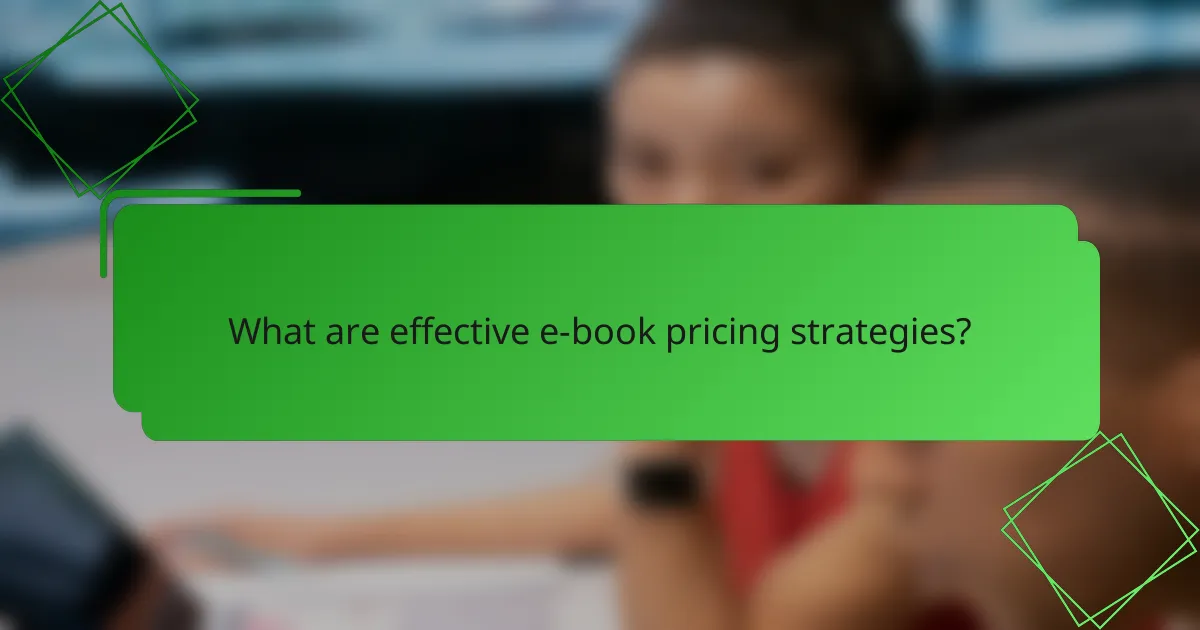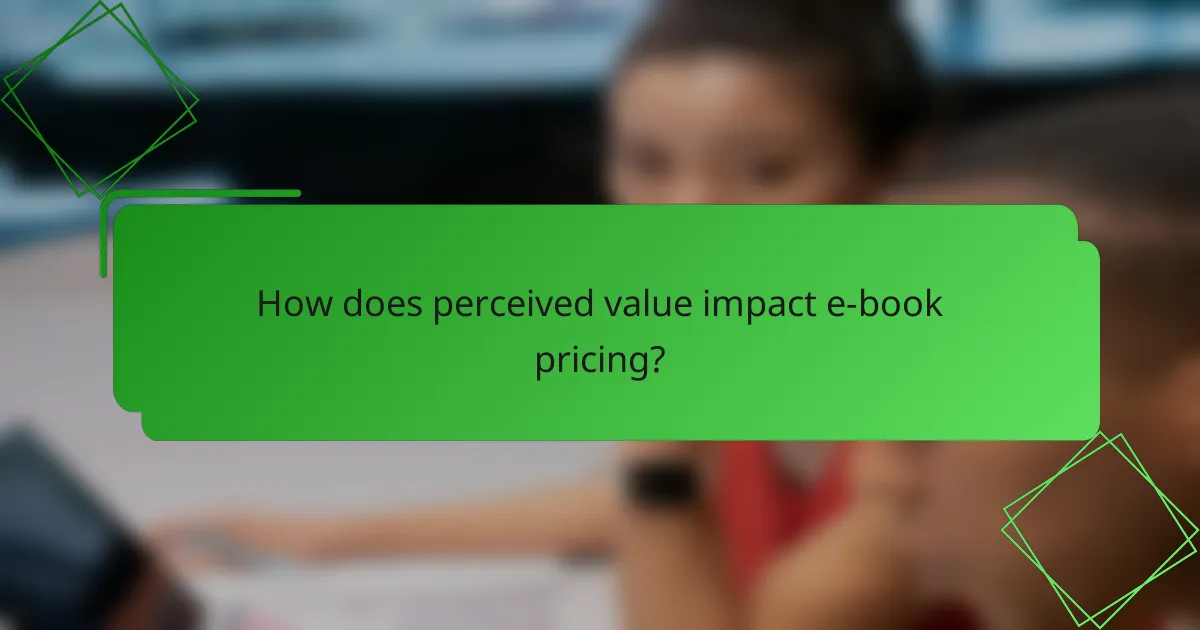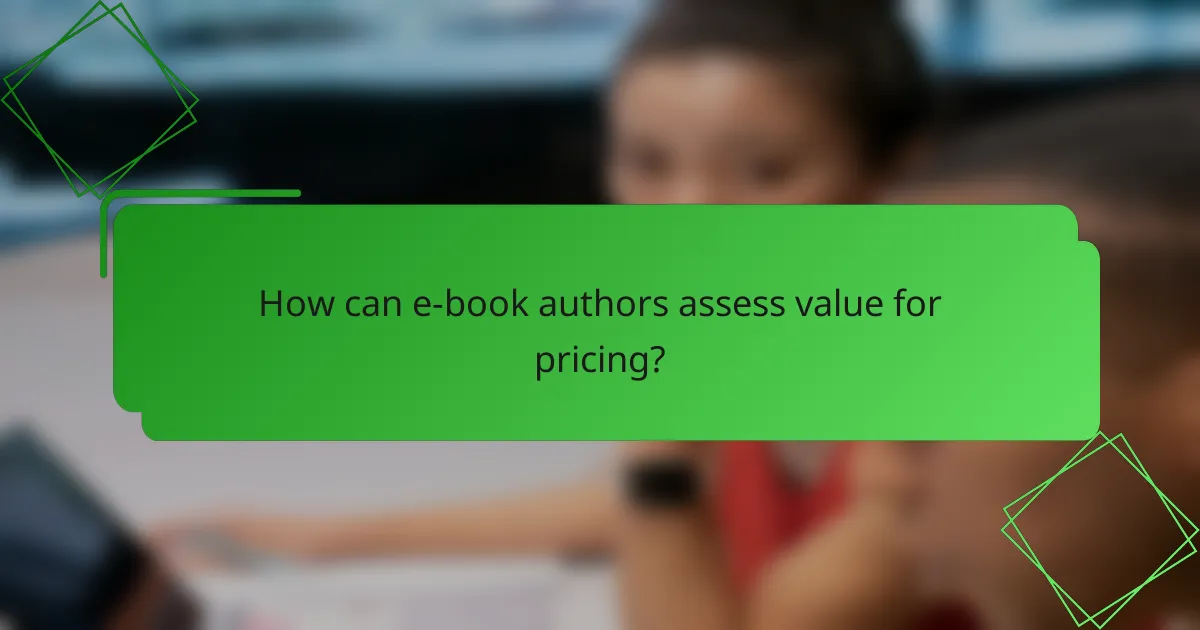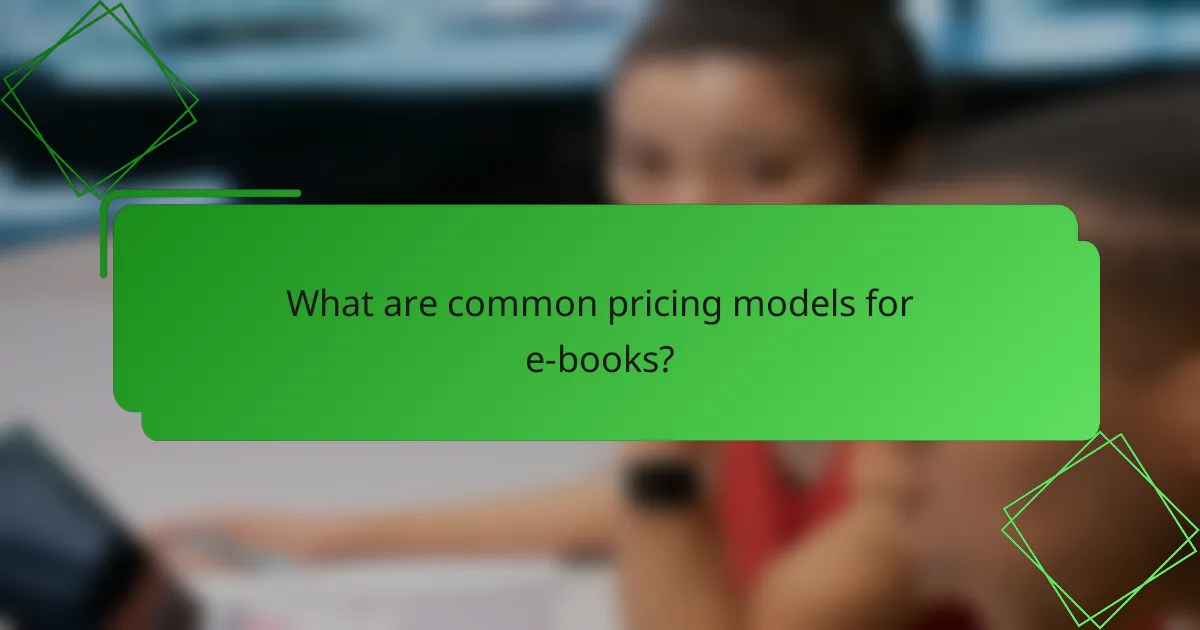In the competitive landscape of e-books, effective pricing strategies are crucial for maximizing revenue while appealing to target customers. By assessing perceived value and market dynamics, authors and publishers can set optimal prices that resonate with readers. Understanding customer perception, influenced by trends and demographics, further enhances the ability to establish competitive pricing that reflects the worth of digital content.

What are effective e-book pricing strategies?
Effective e-book pricing strategies focus on maximizing revenue while appealing to target customers. These strategies consider factors such as perceived value, competition, and market dynamics to set optimal prices.
Value-based pricing
Value-based pricing sets e-book prices based on the perceived value to the customer rather than the cost of production. This approach requires understanding what customers are willing to pay for the content, which can vary widely depending on the genre and target audience.
To implement value-based pricing, conduct surveys or gather feedback to gauge customer preferences. For instance, a specialized non-fiction e-book may command a higher price if it offers unique insights or expert knowledge.
Competitive pricing
Competitive pricing involves setting e-book prices based on the prices of similar offerings in the market. This strategy requires thorough research to identify competitor prices and positioning.
For example, if most similar e-books are priced between $5 and $15, positioning your e-book within this range can help attract buyers. However, ensure that your pricing reflects the quality and uniqueness of your content to avoid being perceived as just another option.
Dynamic pricing
Dynamic pricing adjusts e-book prices based on real-time market demand and other factors. This strategy can maximize revenue by lowering prices during slow sales periods and increasing them when demand spikes.
For instance, using algorithms to analyze sales data can help determine optimal pricing adjustments. Be cautious, as frequent price changes may confuse customers or lead to dissatisfaction if they feel they are missing out on better deals.
Penetration pricing
Penetration pricing sets initial e-book prices low to attract a large number of readers quickly. This strategy is effective for gaining market share, especially for new authors or publishers.
Once a solid reader base is established, prices can gradually increase. An example would be launching an e-book at $2.99 to encourage downloads, then raising the price to $9.99 after achieving a certain sales volume.
Freemium models
Freemium models offer a basic version of an e-book for free while charging for premium content or features. This strategy can attract a wide audience and convert a percentage of users into paying customers.
For example, offering the first chapter of an e-book for free can entice readers, with the full version available for purchase. This model works well in genres where sample content can effectively showcase quality and engage potential buyers.

How does perceived value impact e-book pricing?
Perceived value significantly influences e-book pricing by shaping how customers view the worth of a digital book compared to its cost. When readers believe an e-book offers substantial benefits, they are often willing to pay more, making it essential for authors and publishers to understand and enhance this perception.
Brand reputation
A strong brand reputation can elevate the perceived value of an e-book, allowing for higher pricing. Established authors or publishers with a history of quality content often command premium prices because readers trust their work and expect a certain standard.
To leverage brand reputation, focus on building a recognizable identity through consistent quality, effective marketing, and positive reader engagement. Consider strategies like author branding, social media presence, and reader reviews to enhance visibility and trust.
Content quality
The quality of the content directly affects perceived value and, consequently, pricing. E-books that are well-researched, engaging, and professionally edited are more likely to be valued higher by readers. This includes not only the writing but also the design, formatting, and overall presentation.
Investing in professional editing and design can significantly boost the quality of your e-book. Additionally, gathering feedback from beta readers can help identify areas for improvement before launch, ensuring that the final product meets high standards.
Author credibility
Author credibility plays a crucial role in shaping perceived value. Readers are more inclined to pay a premium for e-books written by authors with expertise or a strong background in the subject matter. This credibility can stem from previous publications, qualifications, or a solid online presence.
To enhance author credibility, consider sharing your qualifications, engaging in public speaking, or contributing to reputable publications. Building a strong online portfolio and actively participating in relevant communities can also help establish you as a trusted voice in your field.

What factors influence customer perception of e-book prices?
Customer perception of e-book prices is influenced by various factors including market trends, customer demographics, and psychological pricing strategies. Understanding these elements can help publishers and authors set competitive prices that resonate with their target audience.
Market trends
Market trends play a crucial role in shaping customer expectations regarding e-book prices. For instance, if the average price of best-selling e-books hovers around $10 to $15, customers may perceive anything significantly higher as overpriced. Keeping an eye on industry reports and competitor pricing can provide valuable insights.
Additionally, seasonal trends, such as holiday sales or promotional events, can affect pricing strategies. Offering discounts during peak shopping seasons can enhance perceived value and drive sales.
Customer demographics
Customer demographics, including age, income level, and reading habits, significantly influence how individuals perceive e-book prices. Younger readers, who are often more tech-savvy, may be more willing to pay for digital content, while older demographics might prefer lower prices or physical books.
Income levels also affect price sensitivity. For example, customers in higher income brackets may not mind paying a premium for exclusive content, while budget-conscious readers may seek out lower-priced options or free titles. Tailoring pricing strategies to specific demographic segments can enhance customer satisfaction.
Psychological pricing
Psychological pricing strategies can significantly impact customer perception of e-book prices. Techniques such as pricing an e-book at $9.99 instead of $10 can create a perception of value, as consumers often associate lower prices with better deals. This strategy can effectively increase sales volume.
Another approach is to bundle e-books or offer subscription models, which can enhance perceived value. For instance, a subscription service offering access to a library of titles for a monthly fee may attract customers who perceive it as a cost-effective solution compared to purchasing individual e-books.

How can e-book authors assess value for pricing?
E-book authors can assess value for pricing by evaluating market demand, understanding customer preferences, and analyzing competitive offerings. This process involves gathering data from various sources to determine an appropriate price point that reflects the perceived value of their work.
Market research tools
Market research tools help authors gather insights about their target audience and competitors. Tools like Google Trends, SEMrush, and social media analytics can reveal popular genres, keywords, and reader interests. By analyzing this data, authors can identify pricing trends and adjust their strategies accordingly.
Additionally, platforms like Statista provide industry reports that can inform authors about average e-book prices in their niche. Understanding these benchmarks allows authors to position their pricing competitively while still reflecting the quality of their work.
Customer feedback surveys
Customer feedback surveys are a direct way to gauge reader perceptions and preferences regarding pricing. Authors can use tools like SurveyMonkey or Google Forms to create surveys that ask readers about their willingness to pay, preferred price ranges, and features they value most in an e-book.
Incentivizing survey participation with discounts or exclusive content can increase response rates. Analyzing this feedback helps authors tailor their pricing strategies to align with customer expectations, enhancing perceived value.
Sales data analysis
Sales data analysis involves reviewing past sales performance to identify pricing patterns and customer behavior. Authors should track metrics such as sales volume, revenue, and customer demographics to understand how different price points affect sales. Tools like Amazon KDP and Draft2Digital provide sales reports that can be invaluable for this analysis.
By comparing sales data before and after price changes, authors can determine the optimal pricing strategy. It’s essential to consider seasonal trends and promotional periods, as these factors can significantly impact sales outcomes.

What are common pricing models for e-books?
Common pricing models for e-books include subscription models, pay-per-download, and bundled pricing. Each model offers unique advantages and considerations that can impact both authors and readers.
Subscription models
Subscription models allow readers to access a library of e-books for a recurring fee, typically monthly or annually. This approach can attract avid readers who prefer variety and frequent reading, as they can explore multiple titles without purchasing each one individually.
Platforms like Kindle Unlimited and Scribd exemplify this model, offering thousands of titles for a flat fee. Authors may benefit from increased exposure, but they should consider the potential for lower individual royalties compared to direct sales.
Pay-per-download
Pay-per-download is a straightforward pricing model where readers purchase e-books individually. This model allows authors to set their own prices, often ranging from a few dollars to higher amounts for specialized content.
While this method can lead to higher earnings per sale, it may limit the audience to those willing to pay upfront. Authors should consider pricing strategies based on genre, audience demand, and competitive offerings to optimize sales.
Bundled pricing
Bundled pricing involves offering multiple e-books together at a discounted rate compared to purchasing each title separately. This strategy can encourage readers to buy more titles and can be particularly effective for series or themed collections.
For example, an author might bundle three novels for a price lower than the total of individual purchases. Bundling can increase perceived value and drive sales, but authors should ensure that the discount does not undermine their pricing strategy or brand perception.


